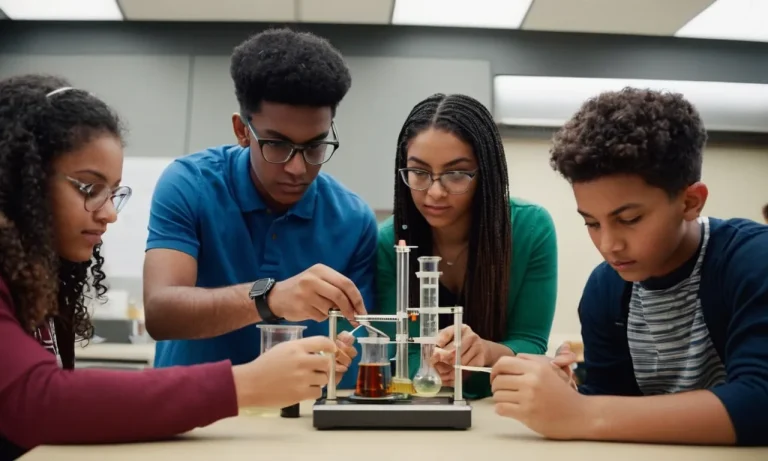High school is a rollercoaster ride of emotions, experiences, and memories that shape our lives forever. From the excitement of new beginnings to the bittersweet goodbyes, each year brings its own set of challenges and triumphs.
But amidst this journey, one year often stands out as the most daunting, the most overwhelming, and the most dreaded – the worst year of high school.
If you’re short on time, here’s a quick answer to your question: The junior year, or the 11th grade, is widely considered the worst year of high school for most students.
In this comprehensive article, we’ll delve into the reasons why the junior year is often regarded as the most challenging, exploring the academic pressures, social dynamics, and personal growth that students face during this pivotal time.
We’ll also provide insights and strategies to help you navigate this year successfully, ensuring that you emerge stronger and better prepared for the future.
The Academic Pressure Cooker
High school years can be an intense academic pressure cooker, especially during the junior and senior years. The demands on students seem to escalate exponentially, leaving them feeling overwhelmed and stressed to the max. Let’s dive into the key contributors to this pressure-filled environment.
Rigorous Course Load
As students progress through high school, the coursework becomes increasingly challenging. They’re expected to take on a rigorous course load, often including Advanced Placement (AP) or International Baccalaureate (IB) classes.
These advanced courses are designed to mimic college-level work and can be incredibly demanding. According to data from the College Board, over 2.8 million students took at least one AP exam in 2022, a testament to the popularity and pressure of these courses.
Standardized Testing Frenzy
The standardized testing frenzy is another major contributor to the academic pressure cooker. Students must prepare for and excel on tests like the SAT or ACT, which play a significant role in college admissions.
The pressure to achieve high scores can be intense, leading many students to enroll in costly test prep courses or hire private tutors. A study by the National Center for Education Statistics found that nearly 60% of high school graduates took the SAT or ACT in 2018. 😨
College Application Stress
The college application process is undoubtedly one of the most stressful aspects of high school, especially for those aiming for top-tier universities. Students must juggle rigorous coursework, extracurricular activities, and the daunting task of crafting compelling essays and applications.
According to data from the National Association for College Admission Counseling, the average student applies to around 7 colleges, adding to the pressure and workload. 😓
The combination of a demanding course load, high-stakes standardized testing, and the college application process creates an academic pressure cooker that can be overwhelming for many high school students. It’s crucial for parents, educators, and counselors to provide support and guidance to help students navigate these challenges while prioritizing their mental and emotional well-being.
Social Dynamics and Personal Growth
Navigating Friendships and Relationships
High school is a pivotal time when friendships and relationships undergo significant changes. During this period, students often reevaluate their social circles and form new connections. According to a study by the American Psychological Association, positive friendships during adolescence can boost self-esteem, promote emotional well-being, and even improve academic performance.
However, navigating these social dynamics can be challenging, as students may face peer pressure, bullying, or even romantic heartbreak. It’s crucial for students to surround themselves with supportive individuals who uplift and encourage their personal growth.
Developing Self-Identity
High school is a time of self-discovery and identity formation. As teenagers navigate this phase, they explore their interests, values, and beliefs, shaping who they want to become. According to a study by the American Psychological Association, approximately 80% of adolescents report experiencing an identity crisis during this period.
This process can be both exciting and overwhelming, as students experiment with different styles, activities, and social groups. Embracing this journey of self-discovery with an open mind and a willingness to learn can be incredibly rewarding, leading to a stronger sense of self and greater confidence.
Balancing Extracurricular Activities
In addition to academic demands, high school students often juggle a variety of extracurricular activities, such as sports, clubs, volunteering, or part-time jobs. While these activities can provide valuable experiences and opportunities for personal growth, finding the right balance can be a challenge.
According to a survey by the National Federation of State High School Associations, approximately 55% of high school students participate in at least one extracurricular activity. However, overcommitting can lead to burnout, stress, and a lack of work-life balance.
It’s essential for students to prioritize their commitments, manage their time effectively, and seek support when needed to maintain a healthy and fulfilling lifestyle.
The high school years can be a rollercoaster of emotions, but they also present invaluable opportunities for personal growth. By navigating friendships and relationships, developing a strong sense of self, and finding a balance between academics and extracurricular activities, students can emerge from this experience with newfound confidence, resilience, and a clearer vision for their future.
Remember, every challenge is an opportunity for growth, and with the right mindset and support system, you can thrive during this transformative period. 😊
Strategies for Surviving the Junior Year
Time Management and Study Skills
The junior year is often considered the most challenging academic year in high school. With increased workloads, extracurricular activities, and the looming pressure of college applications, effective time management and study skills are crucial for success.
Start by creating a detailed schedule that allocates time for classes, homework, extracurriculars, and self-care. Prioritize tasks based on deadlines and importance, and don’t be afraid to say no to commitments that may overwhelm your schedule.
Additionally, explore study techniques like the spaced practice method, which can enhance long-term retention of information.
Seeking Support and Resources
Don’t hesitate to seek support when you need it. Utilize your school’s resources, such as tutoring centers, academic advisors, and counseling services. According to a study by the Educational Testing Service, students who received tutoring showed significant improvements in academic performance.
Additionally, don’t be afraid to ask your teachers for extra help or clarification on challenging concepts. Building strong relationships with your teachers can be incredibly beneficial during this demanding year.
- Did you know? A survey by The Princeton Review found that 84% of college admissions officers consider teacher recommendations when evaluating applications.
Self-Care and Stress Management
Amidst the chaos of the junior year, it’s essential to prioritize your mental and physical well-being. Engage in activities that promote relaxation and stress relief, such as exercise, mindfulness practices, or hobbies you enjoy.
According to the American Psychological Association, regular exercise can help alleviate stress and anxiety. Additionally, make sure to get enough sleep, maintain a balanced diet, and take breaks when needed.
Don’t be afraid to seek professional help if you’re struggling with overwhelming stress or mental health concerns. Remember, your well-being should always be a top priority.
| Stress Management Technique | Potential Benefits |
|---|---|
| Meditation | Improved focus, reduced anxiety |
| Exercise | Boosts mood, releases endorphins |
| Journaling | Emotional release, self-reflection |
The junior year can be overwhelming, but with the right strategies and mindset, you can navigate it successfully. Remember, you’re not alone in this journey, and seeking support when needed is a sign of strength, not weakness.
Stay positive, take care of yourself, and trust that your hard work will pay off in the end. You’ve got this! 👏🎉
Looking Ahead: Embracing the Senior Year
Reflecting on Growth and Accomplishments
As you embark on your senior year of high school, it’s an opportune time to reflect on the incredible journey you’ve undertaken and the remarkable growth you’ve experienced. From the wide-eyed freshman navigating the hallways to the confident senior you’ve become, each year has shaped you in profound ways.
Take a moment to appreciate how far you’ve come and the obstacles you’ve overcome. Celebrate your academic achievements, extracurricular involvements, and personal milestones. According to a National Center for Education Statistics report, the average high school graduation rate in the U.S. has steadily increased, reaching an impressive 88% in 2019.
👏 Your perseverance and dedication have brought you to this pivotal point, and you should feel an immense sense of pride.
Preparing for College or Career
As you approach the finish line of your high school journey, it’s time to shift your focus to the exciting possibilities that lie ahead. For many, this means preparing for the transition to college. Research potential colleges and universities that align with your academic interests and career aspirations.
Attend college fairs, explore scholarship opportunities, and ensure you meet all application deadlines. According to a recent study, approximately 63% of high school graduates enroll in college immediately after graduation.
📚 If you’re considering a different path, explore vocational training programs, apprenticeships, or entry-level job opportunities in your desired field. Utilize resources like CareerOneStop to research potential careers and gain insights into job outlooks and earning potentials.
Cherishing the Final Moments
While it’s essential to plan for the future, don’t forget to savor the present moments with your friends and classmates. These are the final days of your high school experience, and they will soon become cherished memories.
Attend school events, participate in traditions, and make the most of every opportunity to create lasting bonds. According to a study by the American Psychological Association, positive peer relationships during adolescence can have a profound impact on overall well-being and future success.
😊 Reminisce about the hilarious moments, inside jokes, and shared experiences that have brought you closer together. Don’t let the excitement of what’s to come overshadow the joy of the here and now. Embrace the bittersweet emotions, for they signify the end of an era and the beginning of a new, incredible chapter.
Conclusion
The junior year of high school is undoubtedly a challenging and transformative period, but it is also an opportunity for personal growth and self-discovery. By understanding the academic pressures, social dynamics, and personal development that students face during this time, you can better prepare yourself to navigate this year successfully.
Remember, the struggles and triumphs of the junior year are temporary, and the lessons learned will shape you into a stronger, more resilient individual. Embrace the challenges, seek support when needed, and never lose sight of your goals and aspirations.
With determination and perseverance, you can conquer the worst year of high school and emerge victorious, ready to embrace the exciting opportunities that lie ahead.






